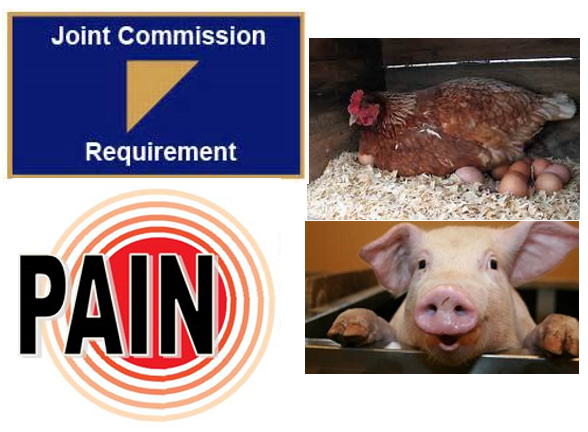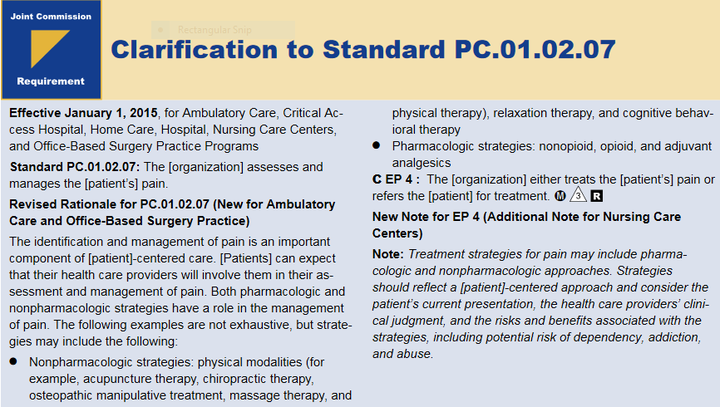
On January 1, 2018, integrative treatment moves from hen to pig in a hospital’s accreditation pain scores
There’s a joke about the different roles of a hen and a pig when it comes to breakfast. It’s used to demonstrate levels of engagement. The hen, with its eggs, contributes. The pig, on the other hand, is utterly committed.
This line captures something the New Year brings to the nation’s relationship to integrative pain treatment. The Joint Commission that accredits most hospitals is transforming non-pharmacologic care from hen to pig when it comes to an organization’ accreditation.
For nearly two decades, guidelines of what was once the Joint Commission on Accreditation of Healthcare Organizations have listed non-pharma approaches as possible contributors. A March 2001 edition of Briefings on JCAHO includes acupuncture, acupressure, massage therapy, aromatherapy, hypnotherapy, art and music therapy and other mind-body via “relaxation techniques.” (See box.) The notice even urges hospitals to respond to patient interest in “non-drug alternatives to pain management.”

The hen’s potential “contributions” have been on the shelf - but few voluntarily added them to their recipes for good pain treatment
None were required. Non-pharma options were kind of like extra credit. Use them if you think they might contribute. The hospital’s scoring mandated zero. We know where this got us: the opioid-focused, chronic pain management crisis.
Starting January 1, 2018, the Era of the Pig begins for integrative pain care in hospital accreditation standards. The “scoring” of pain management strategies of delivery organizations under the Joint Commission will finally include their efforts to offer non-pharma options. They’ll be part of the hospital’s report cards for patients, employers, government agencies and other members of the public. Clinical officers will instruct underlings to do something. Compliance officers will check to see if they have.
It’s been a long journey to this point of presumed action. In 1999, colleagues who were then leaders of large Catholic healthcare systems, Corrine Bayley and Sister Diana Bader shared what was then a recently released Joint Commission guideline. It referenced, although obliquely, non-pharma approaches. Bayley and Bader were exploring complementary and alternative medicine (CAM) strategies as efforts to counter the dehumanization of care delivery through technological adoption and industrial production. The Joint Commission’s mention of non-drug alternatives was the most significant, formal recognition of CAM in any policy. The language was leverage for change - an organizing tool for a better integrated and more humanistic.
Recently massage practitioner and researcher Sylvia Burns, LMP, then part of an integrative pain team at the University of Washington, reminded me of campaign some of us sought to stimulate based on that 1999 language. Through the not-for-profit Collaboration for Healthcare Renewal Foundation with which I was then involved, we created a daylong event at Seattle’s Northwest Hospital in which Burns presented along with Jery Whitworth, RN, CCP, who had partnered with Mehmet Oz, MD at Columbia Presbyterian, and keynoter integrative pain pioneer James Dillard, MD, DC, LAc. Our goal was to present a one-day conference template, tagged to the Joint Commission’s notice, that others could copy then offer in other hospitals across the country. The integrative pain model would advance.
For various reasons - including the lack of a Joint Commission mandate - our organizing strategy never took off. Nor were the non-pharma eggs that were nested in the Joint Commission’s 1999 guideline cooked up into much of anything across the USA’s hospitals and allied clinics. With nothing required, virtually nothing was committed.

The Consortium and acupuncturist-research Nielsen who has spearheaded efforts
The steps leading to the present era of scoring began with a more successful organizing campaign from parts of the integrative health community. In 2013, acupuncturist and researcher Arya Nielson, PhD, LAc, with the backing by the Academic Consortium for Integrative Medicine and Health, approached the Joint Commission. Nielsen had recalled a brief article on the 1999 guideline in The Integrator for the Business of Alternative Medicine. She believed that recent science might awaken more interest in non-pharma approaches. With the backing of 26 Consortium members, she requested that the Commission review the emerging science on non-pharma approaches.
This campaign yielded multiple results. First, the Joint Commission issued a Clarification of Pain Management Standards that went into effect January 2015. This elevated the position of non-pharmacologic options. Yet there was still no scoring requirement. Why bother to work on this, amidst so much that is mandated?
So Nielsen and the Consortium re-upped their campaign in 2016. Using the hammer of the opioid damage and emerging guidelines from other organizations, they urged the Joint Commission to put the teeth of scoring into the clarified pain standards. Following grassroots lobbying from the integrative practice community, the agency finally began to take seriously its role in transforming the nation’s chronic pain strategy. They announced that as of January 1, 2018, the Joint Commission’s scoring of medical organizations on their pain management plans will include their relationship to non-pharma methods.
The transformation from hen to pig of integrative practice in the pain strategies of accredited hospitals was finally complete.

The 2015 Joint Commission guidance with no teeth - no scoring
Maybe. Questions remain. Will the opioid-related morbidity and mortality stemming in part from the Joint Commission’s failure to require non-pharma pain treatment finally awaken the agency to affirmative promotion of non-pharma strategies to support patient safety? Will the agency set a high bar for a hospital’s non-pharma programs then ruthlessly mark down slow-adopters? Or will they sit back, watch and wait?
Experience suggests that the Joint Commission will choose a relatively passive role. If so, hospitals will need additional external pressure to proactively serve up integrative pain care. Community members will need to publicly post failure grades for local hospitals and delivery organizations that don’t actively advance non-pharma strategies as urged by common sense, evidence, and now the Joint Commission’s accreditation requirements.
